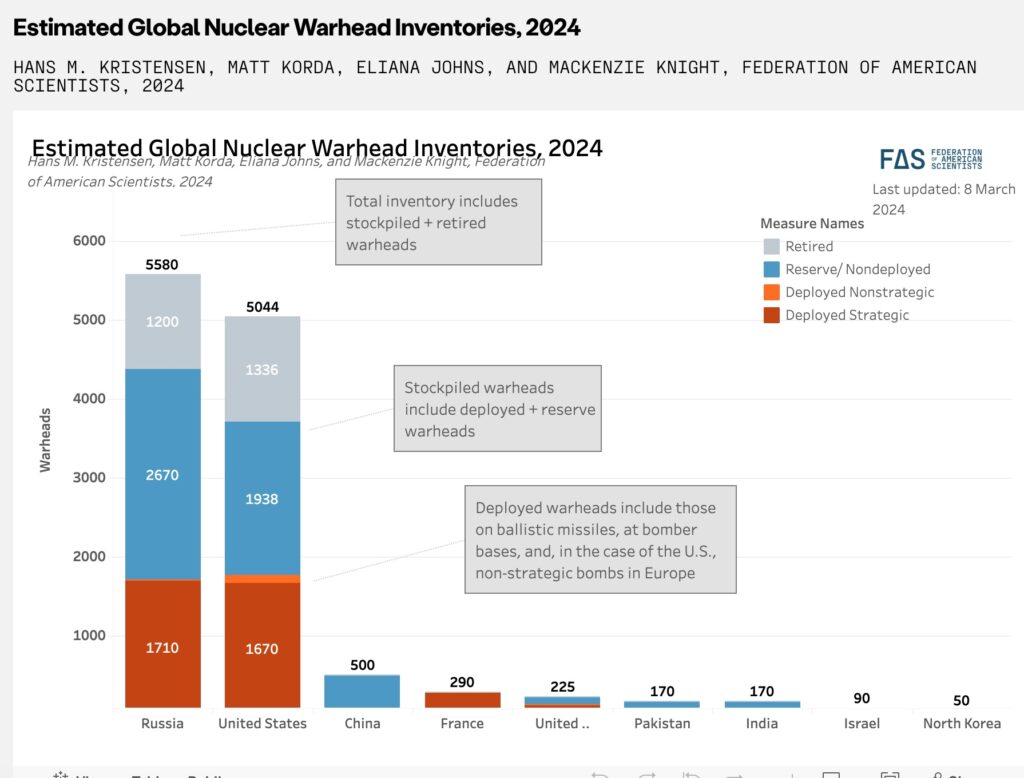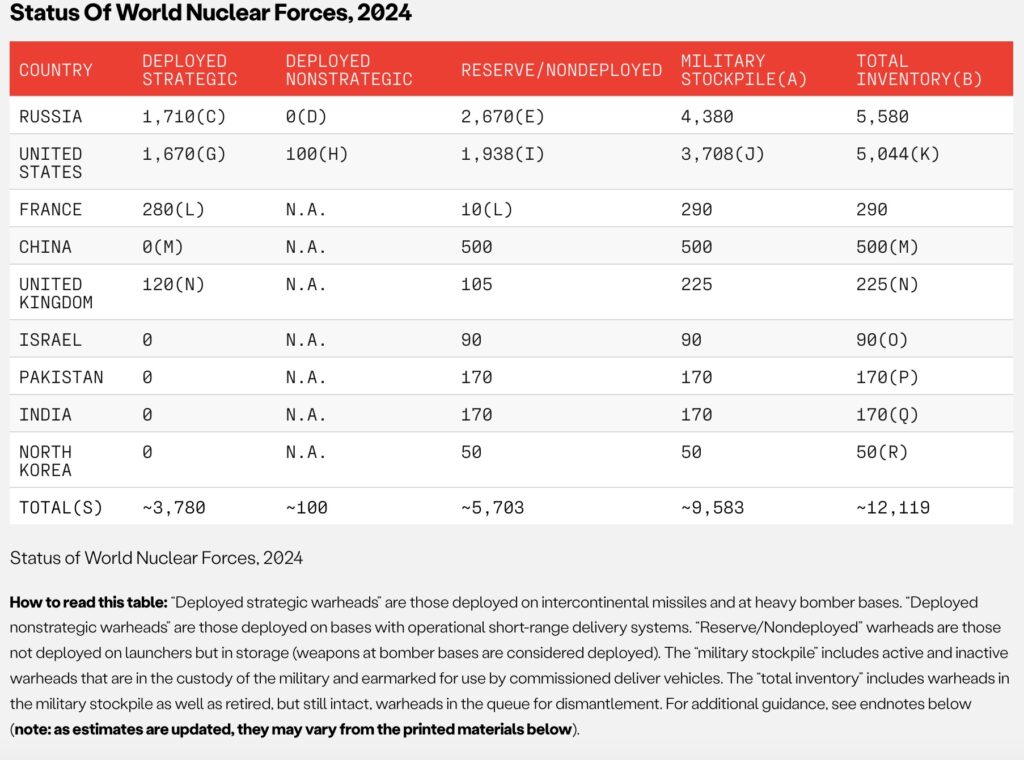Many thanks to Hans Kristensen and the Federation of American Scientists for the use of this information, see https://fas.org/issues/nuclear-weapons/status-world-nuclear-forces/ and https://thebulletin.org/premium/2025-01/united-states-nuclear-weapons-2025/
Instead of planning for nuclear disarmament, the nuclear-armed states appear to plan to retain large arsenals for the indefinite future. All continue to modernize their remaining nuclear forces, and several of these nations are adding new types of nuclear weapons and/or increasing the role that nuclear weapons serve in national strategy and public statements.
For an overview of global modernization programs, see the FAS contribution to the SIPRI Yearbook. Individual country profiles are available from the FAS Nuclear Notebook.

Despite progress in reducing nuclear weapon arsenals since the Cold War, the world’s combined inventory of nuclear warheads remains at a very high level: nine countries possessed roughly 12,100 warheads as of early-2024.
Combined, the United States and Russia now possess approximately 88 percent of the world’s total inventory of nuclear weapons, and 84 percent of the stockpiled warheads available for use by the military. Currently, no other nuclear-armed state sees a need for more than a few hundred nuclear weapons for national security, although many of these states are increasing their nuclear stockpiles.
Globally, the overall inventory of nuclear weapons is declining, but the pace of reductions is slowing compared with the past 30 years. Moreover, these reductions are happening only because the United States and Russia are still dismantling previously retired warheads.
In contrast to the overall inventory of nuclear weapons, the number of warheads in global military stockpiles – which comprises warheads assigned to operational forces – is increasing once again. The United States is still reducing its nuclear stockpile slowly. France and Israel have relatively stable inventories. But China, India, North Korea, Pakistan and the United Kingdom, as well as possibly Russia, are all thought to be increasing their stockpiles.
Of the world’s approximate 12,100 nuclear warheads, roughly 9,583 are in the military stockpiles for use by missiles, aircraft, ships and submarines. The remaining warheads have been retired but are still relatively intact and are awaiting dismantlement). Of the 9,583 warheads in the military stockpiles, some 3,880 are deployed with operational forces (on missiles or bomber bases). Of those, approximately 2,000 US, Russian, British and French warheads are on high alert, ready for use on short notice.
According to a 2017 Briefing Paper by Hans Kristensen, the US and Russia each had more than 800 strategic nuclear warheads at launch-ready status, meaning that they could launch these warheads with 2 to 15 minutes warning.

How to read this table: “Deployed strategic warheads” are those deployed on intercontinental missiles and at heavy bomber bases. “Deployed nonstrategic warheads” are those deployed on bases with operational short-range delivery systems. “Reserve/Nondeployed” warheads are those not deployed on launchers and in storage (weapons at bomber bases are considered deployed). The “military stockpile” includes active and inactive warheads that are in the custody of the military and earmarked for use by commissioned deliver vehicles. The “total inventory” includes warheads in the military stockpile as well as retired, but still intact, warheads in the queue for dismantlement. For additional guidance, see endnotes below.
a Warheads in the “military stockpile” are defined as warheads in the custody of the military and earmarked for use by military forces.
b The “total inventory” counts warheads in the military stockpile as well as retired, but still intact, warheads awaiting dismantlement.
c This number is higher than the aggregate data under the New START Treaty because this table also counts bomber weapons at bomber bases as deployed. Detailed overview of Russian forces as of 2024 is here. Numbers have been updated for later changes.
d All are declared to be in central storage, although some storage sites may be close to bases with operational forces. Many retired non-strategic warheads are thought to be awaiting dismantlement.
e Includes an estimated 1,112 strategic warheads and all 1,558 non-strategic warheads.
f In addition to the 4,380 warheads in the military stockpile, an estimated 1,200 retired warheads are thought to be awaiting dismantlement. Public details are scarce, but we estimate that Russia is dismantling 200-300 retired warheads per year. The future of the Russian stockpile size is debated: US Strategic Command and part of the Intelligence Community claim “Russia’s overall nuclear stockpile is likely to grow significantly over the next decade – growth driven primarily by a projected increase in Russia’s non-strategic nuclear weapons.” Others privately disagree. A major uncertainty is how many tactical weapons will be replaced by new nuclear versions versus conventional weapons. See 2024 overview of Russian forces here.
g This number is higher than the aggregate data released under the New START data because this table also counts bomber weapons on bomber bases as deployed. Detailed overview of 2024 U.S. forces is here.
h Approximately 100 B61 bombs are deployed in Europe at six bases in five countries (Belgium, Germany, Italy, Netherlands, and Turkey).
i Non-deployed reserve includes an estimated 1,670 strategic and 100 non-strategic warheads in central storage.
j The U.S. government declared in March 2018 that its stockpile included 3,822 warheads as of September 2017. After that, the Trump administration decided no longer to declassify the numbers. In 2021, the Biden administration declassified the number of warheads in the stockpile and the number of dismantled warheads, noting that the stockpile consisted of 3,750 warheads as of September 2020. Since then, additional warheads have been retired for an estimated stockpile of approximately 3,700 warheads.
k In addition to the roughly 3,700 warheads in the military stockpile and the approximate 1,500 retired warheads awaiting dismantlement, roughly 20,000 plutonium cores (pits) and some 4,000 Canned Assemblies (secondaries) from dismantled warheads are in storage at the Pantex Plant in Texas and Y-12 plant in Tennessee. For a detailed 2023 overview of U.S. forces, see here.
l Weapons for France’s single aircraft carrier are not deployed on the ship under normal circumstances but could be on short notice. Warhead loadings on some submarines missiles have been reduced to increase targeting flexibility. For a detailed overview of French nuclear forces, see here).
m The Chinese stockpile is increasing, and in 2022 the US Department of Defense claimed that by 2030 China’s nuclear stockpile “will have about 1,000 operational nuclear warheads.” Part of that increase is already well underway and our estimate includes some of it; however, these claims depend on many uncertain factors, including how many missile silos will be built, how many warheads each missile will carry, and assumptions about the future production of fissile materials by China. None of the warheads are thought to be fully deployed but kept in storage under central control. China considers all of its nuclear weapons to be strategic, but the US military calls its medium-and intermediate-range missile non-strategic. Our detailed 2024 overview of Chinese nuclear forces is here.
n The number of British warheads on each submarine was lowered from 48 to 40. This lowered the number of “operationally available” warheads from 160 to 120. The plan was to reduce the stockpile to “not more than 180” by the mid-2020s, but the Johnson government announced in 2021 that it would increase the stockpile to “no more than 260 warheads.” Detailed overview of UK nuclear forces here.
o Although Israel has produced enough plutonium for 100-200 warheads, the number of delivery platforms and estimates made by the U.S. intelligence community suggest that the stockpile might include approximately 90 warheads. Detailed 2021 overview here.
p Estimating the number of Pakistani warheads comes with great uncertainty because neither Pakistan nor western governments provide public information. None of Pakistan’s warheads are thought to be mated with missiles but kept in central storage, most in the southern parts of the country. More warheads are in production. Detailed 2023 overview here.
q Estimating the number of Indian warheads comes with great uncertainty because neither Indian nor western governments provide public information. Despite efforts to increase readiness, we estimate Indian nuclear warheads are not mated with missiles but in central storage. Bomber weapons could probably be employed on relatively short notice. More warheads are in production. Detailed 2022 overview here.
r After six nuclear tests, including two of 10-20 kilotons and one of more than 150 kilotons, we estimate that North Korea might have produced sufficient fissile material for roughly 50-70 warheads. The number of assembled warheads is unknown, but lower. We estimate that North Korea might have approximately 30 assembled warheads for short- and medium-range missiles, although this number is certainly increasing. Detailed 2022 overview here.
s Numbers may not add up due to rounding and uncertainty about the operational status of the four lesser nuclear weapons states and the uncertainty about the size of the total inventories of three of the five initial nuclear powers.
